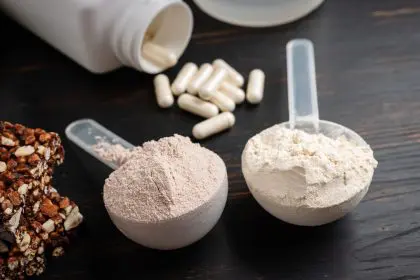The foundation of any successful weight gain plan begins with understanding exactly how many calories your body needs. While general guidelines suggest that underweight individuals need 300-500 extra calories daily to gain weight, this approach lacks the precision needed for optimal results.
To gain weight effectively, first determine your Total Daily Energy Expenditure (TDEE)—the total calories your body burns throughout the day. Several factors influence this number, including your basal metabolic rate, physical activity level, and something called the thermic effect of food.
Online TDEE calculators provide a helpful starting point, but these estimates often require adjustments based on real-world results. Track your actual calorie intake for one week while monitoring your weight. If the scale doesn’t budge, increase your daily intake by 300-500 calories and reassess after another week.
Most people with fast metabolisms or naturally thin body types find they need substantially more calories than standard calculations suggest. Some hardgainers may require upwards of 3,000-3,500 calories daily to see noticeable gains, particularly if they maintain active lifestyles or participate in sports.
Creating a consistent calorie surplus matters more than occasionally eating large amounts. Your body builds new tissue through sustained nutritional abundance, not sporadic overfeeding. This means prioritizing regular meals and snacks even when appetite feels limited.
Choose calorie-dense foods over volume
Not all calories contribute equally to weight gain goals. While vegetables and lean proteins offer excellent nutrition, their high volume and low calorie density make them inefficient choices for those struggling to consume sufficient calories.
Foods with high calorie density deliver more energy in smaller portions, making it easier to reach calorie targets without feeling uncomfortably full. This approach proves particularly valuable for individuals with naturally small appetites or those who feel satiated quickly.
Nuts and nut butters rank among the most effective calorie-dense options, providing approximately 170-200 calories per ounce along with healthy fats, protein, and minimal volume. Just two tablespoons of peanut or almond butter adds nearly 200 calories to shakes, oatmeal, or toast without significantly increasing fullness.
Oils represent another powerful addition to the weight gain arsenal. A single tablespoon of olive or avocado oil contributes 120 calories and can be easily incorporated into cooking, drizzled over finished meals, or blended into smoothies without affecting taste or creating fullness.
Dried fruits offer concentrated nutrition and calories compared to their fresh counterparts. A small handful of dried apricots, mangoes, or raisins provides approximately 100 calories and beneficial micronutrients while taking up minimal stomach space.
Dairy products, particularly full-fat versions, deliver substantial calories alongside complete protein and calcium. Whole milk, Greek yogurt, and cheese create satisfying additions to meals and snacks while supporting both weight and muscle gain goals.
Avocados make an excellent addition to the calorie-dense approach, offering about 320 calories per medium fruit along with fiber, potassium, and heart-healthy monounsaturated fats. Their mild flavor integrates easily into both sweet and savory dishes.
When selecting calorie-dense foods, prioritize those that offer nutritional benefits beyond just energy. The goal involves gaining primarily muscle tissue rather than excessive fat, which requires quality nutrition rather than empty calories from highly processed foods.
Increase meal frequency rather than size
Many naturally thin individuals struggle with large meals, experiencing discomfort, early satiety, or diminished appetite for hours afterward. For these “hardgainers,” increasing meal frequency often proves more effective than attempting to consume larger portions.
Instead of the traditional three meals daily, aim for five to six smaller meals spaced evenly throughout the day. This approach maintains a steady calorie influx while preventing the uncomfortable fullness that might otherwise discourage eating.
Liquid nutrition makes implementing this strategy significantly easier. Calorie-rich smoothies and shakes can supplement solid meals without creating the same feeling of fullness. A basic weight-gain shake might include milk, banana, protein powder, nut butter, and honey, easily delivering 500-700 calories.
Pre-planning becomes essential when increasing meal frequency. Prepare portable, calorie-dense options in advance to ensure constant access to nutrition regardless of schedule or location. Trail mix, protein bars, and prepared shakes work well in this capacity.
Setting reminders can help establish this new eating pattern. Many individuals with fast metabolisms simply forget to eat when busy or distracted, unintentionally creating calorie deficits. Phone alarms or calendar notifications can prompt regular nutritional intake.
The timing between larger meals and smaller snacks requires strategic planning. Spacing eating occasions approximately 2-3 hours apart prevents appetite suppression while maintaining elevated anabolic signals throughout the day.
Prioritize strength training with compound movements
While nutrition provides the building blocks for weight gain, proper resistance training creates the stimulus that directs calories toward muscle building rather than fat storage. The type and structure of workouts significantly impact weight gain results.
Compound exercises that engage multiple large muscle groups simultaneously create the most powerful growth stimulus. Squats, deadlifts, bench presses, rows, and overhead presses trigger releases of muscle-building hormones while activating extensive muscle fiber networks.
Training volume—the total amount of work performed—plays a crucial role in stimulating muscle growth. For weight gain purposes, moderate rep ranges of 8-12 per set typically work best, balancing adequate time under tension with sufficient load to stimulate growth.
Workout frequency should provide sufficient recovery while maintaining regular growth signals. Most people respond well to full-body routines performed three times weekly or upper/lower body splits performed four times weekly. This frequency maximizes the muscle protein synthesis response that drives tissue growth.
Progressive overload—gradually increasing the demands placed on muscles—creates the ongoing stimulus needed for continued development. Add weight, increase repetitions, or reduce rest periods between sets to ensure muscles face constant adaptive challenges.
Rest periods between sets impact workout effectiveness for weight gain. Shorter rest periods (60-90 seconds) increase metabolic stress and growth hormone release, while longer periods (2-3 minutes) allow for heavier loads that create mechanical tension—both important factors in muscle growth.
Contrary to popular belief, excessive cardio can hinder weight gain efforts by burning valuable calories needed for tissue building. Limit cardiovascular training to 2-3 brief sessions weekly, focusing on high-intensity intervals rather than extended steady-state work to minimize calorie expenditure.
Monitor protein timing and distribution
While total daily protein intake significantly influences weight gain success, the distribution of protein throughout the day plays an equally important role. Research indicates that muscle protein synthesis—the process of building new muscle tissue—responds best to frequent protein feedings.
The post-workout period creates a particularly favorable environment for nutrient uptake and tissue building. Consuming 20-40 grams of high-quality protein within 30-60 minutes after training enhances recovery and growth by delivering amino acids when muscle receptivity peaks.
The pre-sleep period offers another valuable opportunity to support weight gain. A slow-digesting protein source like casein before bedtime provides a sustained amino acid release during sleep—when repair processes accelerate. This prevents the overnight catabolism (muscle breakdown) that otherwise occurs during extended fasting.
For optimal results, distribute protein intake relatively evenly across daily meals rather than concentrating it at dinner. Each major meal should include 25-40 grams of complete protein to maintain elevated muscle protein synthesis throughout the day.
Protein quality matters significantly for weight gain outcomes. Focus on complete protein sources containing all essential amino acids, particularly those rich in leucine—the key amino acid that triggers muscle protein synthesis. Eggs, dairy, meat, fish, and poultry excel in this regard.
Plant-based individuals seeking weight gain should combine complementary protein sources to ensure complete amino acid profiles. Pairing legumes with rice, nuts, or seeds creates nutritionally complete combinations that support muscle development.
While whole food protein sources typically offer superior nutritional profiles, protein supplements provide valuable convenience for meeting distribution targets. Whey protein works well around workouts due to rapid absorption, while casein serves effectively as an evening option.
Understand supplement strategies that actually work
The supplement industry markets countless products promising rapid weight gain, but only a handful offer meaningful benefits backed by scientific evidence. Understanding which supplements genuinely support weight gain goals allows for strategic investment rather than wasted resources.
Protein powders rank among the most useful supplements for those seeking weight gain. Beyond convenience, they deliver precisely measured amounts of highly bioavailable protein without excessive fullness. Whey protein isolate, concentrate, and casein each offer unique advantages depending on timing and goals.
Weight gainer products combine protein with carbohydrates and sometimes fats to create extremely calorie-dense options. While convenient, many commercial gainers contain excessive sugar and questionable ingredients. Creating custom versions at home using protein powder, oats, banana, nut butter, and honey often produces healthier, equally effective alternatives.
Creatine monohydrate represents the most extensively researched and consistently effective supplement for supporting weight gain. By increasing cellular water content, enhancing energy availability during workouts, and supporting protein synthesis, creatine helps users gain 2-5 pounds within the first week while enhancing strength and work capacity.
Essential amino acids (EAAs), particularly leucine, can help overcome appetite limitations by stimulating muscle protein synthesis without requiring large food volumes. These supplements prove particularly valuable between meals or during periods when whole food consumption feels challenging.
Digestive enzymes benefit individuals who experience gastrointestinal discomfort when increasing food intake. These supplements enhance nutrient breakdown and absorption, potentially allowing for greater calorie consumption without digestive distress.
While mass-building supplements can contribute to weight gain success, they remain supplements to—not replacements for—a fundamentally sound nutrition and training program. No supplement overcomes inconsistent eating or ineffective workouts.
Manage recovery to support growth
The body builds new tissue during recovery periods, not during workouts themselves. Optimizing recovery factors dramatically influences weight gain success, particularly for individuals with naturally fast metabolisms or high activity levels.
Sleep quality and duration create the foundation for effective recovery. During deep sleep, growth hormone reaches peak production, driving tissue repair and growth. Most individuals require 7-9 hours nightly, though those actively gaining weight may benefit from the upper end of this range or slightly beyond.
Stress management significantly impacts weight gain potential through hormonal pathways. Chronic elevation of cortisol—a stress hormone—promotes catabolism (tissue breakdown) while inhibiting anabolism (tissue building). Meditation, nature exposure, and social connection help moderate stress responses.
Overtraining prevents weight gain by elevating cortisol, increasing calorie expenditure, and impairing recovery capacity. Signs include persistent fatigue, declining performance, disturbed sleep, and reduced appetite. When these appear, reducing training volume and intensity for 1-2 weeks allows recovery systems to normalize.
Strategic deloads—planned periods of reduced training intensity—prevent overtraining while allowing accumulated fatigue to dissipate. Incorporating a deload week every 4-8 weeks maintains progress by balancing stimulus with recovery over the long term.
Active recovery techniques like light walking, swimming, or yoga improve circulation to muscles without creating additional breakdown. These activities accelerate nutrient delivery and waste removal, enhancing the overall recovery process between more intense training sessions.
Contrast therapy—alternating between hot and cold exposure—can accelerate recovery for those with particularly demanding training regimens. This approach reduces inflammation and muscle soreness while improving circulation to tissues undergoing repair and growth.
Track progress with multiple metrics
The bathroom scale provides valuable feedback but offers only a narrow perspective on weight gain progress. Incorporating multiple measurement approaches creates a more complete picture and helps guide program adjustments.
Body measurements, particularly at the chest, shoulders, arms, thighs, and waist, often reveal growth patterns before scale weight changes significantly. Muscle development in specific areas demonstrates program effectiveness even when overall weight changes remain modest.
Progress photos taken under consistent lighting and positioning conditions allow visual comparison over time. These images frequently capture improvements in muscle fullness, definition, and proportion that measurements might miss.
Strength increases correlate strongly with muscle development. Regularly testing performance on key exercises like squats, deadlifts, and presses provides objective feedback on whether the program supports functional improvements alongside aesthetic changes.
Body composition assessments using methods like bioelectrical impedance or DEXA scans help distinguish between muscle and fat gain. While some fat increase typically accompanies muscle building, maintaining a reasonable ratio ensures gains contribute to health and performance rather than detracting from them.
Energy levels and recovery capacity offer subjective but valuable progress indicators. Improving workout performance, reduced soreness duration, and better overall vitality suggest the program supports physiological adaptation rather than creating excessive stress.
When progress stalls, systematic evaluation of these metrics helps identify appropriate adjustments. Plateaus in scale weight accompanied by continuing strength gains and stable measurements often indicate favorable body composition changes rather than true stagnation.
Adjust strategies for different body types
Genetic factors significantly influence how individuals respond to weight gain strategies. Understanding your body type—typically categorized as ectomorph, mesomorph, or endomorph—allows for more personalized and effective approaches.
True ectomorphs—characterized by naturally lean builds, fast metabolisms, and difficulty gaining weight—typically require the most aggressive calorie surpluses, often 500-1,000 above maintenance. These individuals benefit from extremely calorie-dense nutrition strategies and moderate training volumes that stimulate growth without excessive calorie burning.
Mesomorphs, with their naturally athletic builds and moderate metabolic rates, usually respond well to more balanced approaches. Moderate calorie surpluses of 300-500 daily combined with progressive resistance training create steady, sustainable gains with favorable muscle-to-fat ratios.
Endomorphs gain weight relatively easily but often struggle with fat-to-muscle ratios. These individuals benefit from more modest surpluses of 200-300 calories, higher protein intakes, and careful attention to carbohydrate timing around workouts to direct nutrients toward muscle rather than fat tissue.
Mixed body types—which most people possess to some degree—require experimental approaches to identify optimal strategies. Begin with moderate interventions based on your dominant characteristics, then adjust based on measured outcomes over 3-4 week periods.
Age influences weight gain approaches as well. Younger individuals typically demonstrate more robust hormonal responses to training and nutrition, often gaining effectively with higher carbohydrate intakes and training frequencies. After age 40, emphasizing protein intake, recovery quality, and strategic training intensity becomes increasingly important.
Women seeking weight gain face unique considerations including different hormonal environments and often greater concerns about fat distribution. Typically, slightly smaller calorie surpluses combined with substantial strength training create the most favorable outcomes without excessive fat accumulation.
The weight gain journey requires patience and consistency above all else. While genetics influence the rate and pattern of gains, virtually everyone can achieve significant improvements through sustained application of these principles adjusted to their individual response patterns.
With strategic nutrition emphasizing calorie density and frequency, effective training focused on progressive overload, attentive recovery practices, and personalized adjustments based on measured outcomes, healthy weight gain becomes an achievable goal for even the most challenging body types.
















